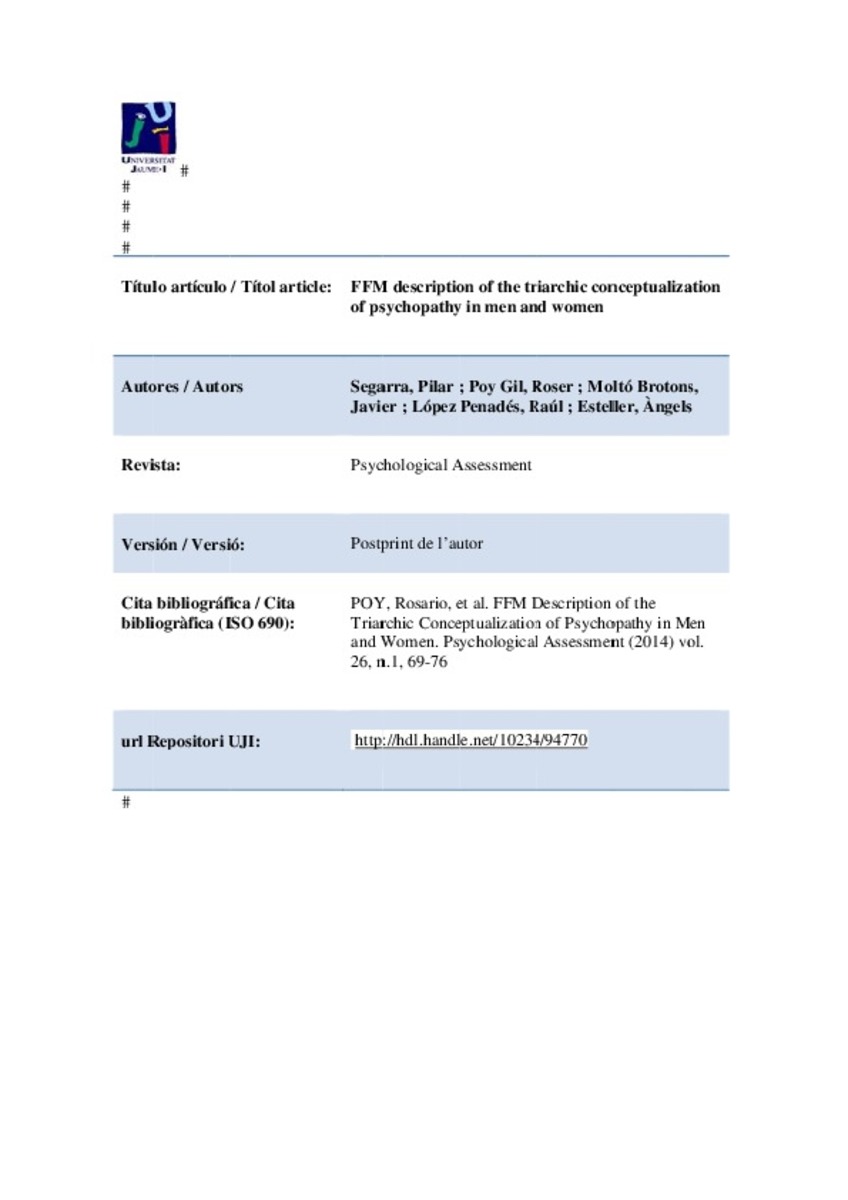Mostrar el registro sencillo del ítem
FFM description of the triarchic conceptualization of psychopathy in men and women
| dc.contributor.author | Segarra, Pilar | |
| dc.contributor.author | Poy, Rosario | |
| dc.contributor.author | Molto, Javier | |
| dc.contributor.author | López Penadés, Raúl | |
| dc.contributor.author | Esteller, Àngels | |
| dc.date.accessioned | 2014-06-13T07:29:57Z | |
| dc.date.available | 2014-06-13T07:29:57Z | |
| dc.date.issued | 2014 | |
| dc.identifier.issn | 1040-3590 | |
| dc.identifier.issn | 1939-134X | |
| dc.identifier.uri | http://hdl.handle.net/10234/94770 | |
| dc.description.abstract | This study examined differential associations between phenotypic domains of the triarchic conceptualization of psychopathy (boldness, meanness, and disinhibition; Patrick, Fowles, & Krueger, 2009), as assessed by the Triarchic Psychopathy Measure (Patrick, 2010b), and the five-factor model (FFM) of normal personality, as indexed by the Revised NEO Personality Inventory (Costa & McCrae, 1992; Spanish version, Costa & McCrae, 1999), in 349 undergraduates (96 men). Distinctive patterns of correlations for psychopathy components did not differ significantly across gender, although relations between Meanness and Agreeableness were stronger for men than for women. Our findings are largely consistent with the conceptualization of psychopathy in terms of FFM constructs and provide discriminant evidence in support of all 3 triarchic domains. Thus, meanness is marked by low Agreeableness and some degree of low Conscientiousness, whereas disinhibition is characterized both by low Conscientiousness and low Agreeableness along with high Neuroticism and Extraversion. Notably, the constellation of low Neuroticism, high Extraversion, and high Openness, with facets of low Agreeableness, supports the idea that boldness encompasses some adaptive features of psychological adjustment while depicting the interpersonal features of psychopathy. | ca_CA |
| dc.format.mimetype | application/pdf | ca_CA |
| dc.language.iso | eng | ca_CA |
| dc.publisher | American Psychological Association | ca_CA |
| dc.relation.isPartOf | Psychological Assessment (2014) vol. 26, n.1, 69-76 | ca_CA |
| dc.rights | © American Psychological Association 'This article may not exactly replicate the final version published in the APA journal. It is not the copy of record.' | ca_CA |
| dc.rights.uri | http://rightsstatements.org/vocab/InC/1.0/ | * |
| dc.subject | Five-factor model (FFM) | ca_CA |
| dc.subject | Gender differences | ca_CA |
| dc.subject | Triarchic model of psychopathy | ca_CA |
| dc.title | FFM description of the triarchic conceptualization of psychopathy in men and women | ca_CA |
| dc.type | info:eu-repo/semantics/article | ca_CA |
| dc.identifier.doi | http://dx.doi.org/10.1037/a0034642 | |
| dc.rights.accessRights | info:eu-repo/semantics/openAccess | ca_CA |
| dc.relation.publisherVersion | http://psycnet.apa.org/journals/pas/26/1/69/ | ca_CA |
| dc.edition | Postprint de l’autor | ca_CA |
| dc.type.version | info:eu-repo/semantics/submittedVersion | ca_CA |
Ficheros en el ítem
Este ítem aparece en la(s) siguiente(s) colección(ones)
-
PSB_Articles [1330]
Articles de publicacions periòdiques







